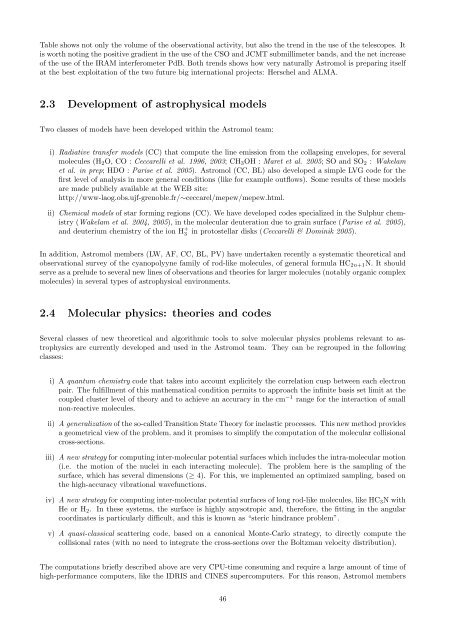Untitled - Laboratoire d'Astrophysique de l'Observatoire de Grenoble
Untitled - Laboratoire d'Astrophysique de l'Observatoire de Grenoble
Untitled - Laboratoire d'Astrophysique de l'Observatoire de Grenoble
You also want an ePaper? Increase the reach of your titles
YUMPU automatically turns print PDFs into web optimized ePapers that Google loves.
Table shows not only the volume of the observational activity, but also the trend in the use of the telescopes. It<br />
is worth noting the positive gradient in the use of the CSO and JCMT submillimeter bands, and the net increase<br />
of the use of the IRAM interferometer PdB. Both trends shows how very naturally Astromol is preparing itself<br />
at the best exploitation of the two future big international projects: Herschel and ALMA.<br />
2.3 Development of astrophysical mo<strong>de</strong>ls<br />
Two classes of mo<strong>de</strong>ls have been <strong>de</strong>veloped within the Astromol team:<br />
i) Radiative transfer mo<strong>de</strong>ls (CC) that compute the line emission from the collapsing envelopes, for several<br />
molecules (H2O, CO : Ceccarelli et al. 1996, 2003; CH3OH : Maret et al. 2005; SO and SO2 : Wakelam<br />
et al. in prep; HDO : Parise et al. 2005). Astromol (CC, BL) also <strong>de</strong>veloped a simple LVG co<strong>de</strong> for the<br />
first level of analysis in more general conditions (like for example outflows). Some results of these mo<strong>de</strong>ls<br />
are ma<strong>de</strong> publicly available at the WEB site:<br />
http://www-laog.obs.ujf-grenoble.fr/∼ceccarel/mepew/mepew.html.<br />
ii) Chemical mo<strong>de</strong>ls of star forming regions (CC). We have <strong>de</strong>veloped co<strong>de</strong>s specialized in the Sulphur chem-<br />
istry (Wakelam et al. 2004, 2005), in the molecular <strong>de</strong>uteration due to grain surface (Parise et al. 2005),<br />
and <strong>de</strong>uterium chemistry of the ion H + 3 in protostellar disks (Ceccarelli & Dominik 2005).<br />
In addition, Astromol members (LW, AF, CC, BL, PV) have un<strong>de</strong>rtaken recently a systematic theoretical and<br />
observational survey of the cyanopolyyne family of rod-like molecules, of general formula HC2n+1N. It should<br />
serve as a prelu<strong>de</strong> to several new lines of observations and theories for larger molecules (notably organic complex<br />
molecules) in several types of astrophysical environments.<br />
2.4 Molecular physics: theories and co<strong>de</strong>s<br />
Several classes of new theoretical and algorithmic tools to solve molecular physics problems relevant to astrophysics<br />
are currently <strong>de</strong>veloped and used in the Astromol team. They can be regrouped in the following<br />
classes:<br />
i) A quantum chemistry co<strong>de</strong> that takes into account explicitely the correlation cusp between each electron<br />
pair. The fulfillment of this mathematical condition permits to approach the infinite basis set limit at the<br />
coupled cluster level of theory and to achieve an accuracy in the cm −1 range for the interaction of small<br />
non-reactive molecules.<br />
ii) A generalization of the so-called Transition State Theory for inelastic processes. This new method provi<strong>de</strong>s<br />
a geometrical view of the problem, and it promises to simplify the computation of the molecular collisional<br />
cross-sections.<br />
iii) A new strategy for computing inter-molecular potential surfaces which inclu<strong>de</strong>s the intra-molecular motion<br />
(i.e. the motion of the nuclei in each interacting molecule). The problem here is the sampling of the<br />
surface, which has several dimensions (≥ 4). For this, we implemented an optimized sampling, based on<br />
the high-accuracy vibrational wavefunctions.<br />
iv) A new strategy for computing inter-molecular potential surfaces of long rod-like molecules, like HC3N with<br />
He or H2. In these systems, the surface is highly anysotropic and, therefore, the fitting in the angular<br />
coordinates is particularly difficult, and this is known as “steric hindrance problem”.<br />
v) A quasi-classical scattering co<strong>de</strong>, based on a canonical Monte-Carlo strategy, to directly compute the<br />
collisional rates (with no need to integrate the cross-sections over the Boltzman velocity distribution).<br />
The computations briefly <strong>de</strong>scribed above are very CPU-time consuming and require a large amount of time of<br />
high-performance computers, like the IDRIS and CINES supercomputers. For this reason, Astromol members<br />
46




